Material Guide: Butyl Rubber
Our Guide To IIR – Butyl Rubber
Butyl rubber, also known as Isobutylene – Isoprene (IIR), is a synthetic rubber developed in the 1940s. IIR has exceptionally low gas permeability, making it ideal for inner tubes and high pressure/vacuum sealing applications.
What Are The Advantages Of IIR?
Butyl rubber’s very low resilience makes it suitable for shock and vibration damping, while its chemical unsaturation gives it excellent resistance to heat, ozone, and weathering. IIR can also be used in dilute acids and alkalis. IRR also provides high-energy absorption and electrical isolation performance.

What Are The Disadvantages Of IIR?
IIR is not suitable for use in mineral or petroleum-based fluids.
What Are The Typical Applications Of Butyl Rubber?
Typical applications include:
- Diaphragms
- Gaskets
- Inner tubes
- Liners
- O-rings
- Pharmaceutical & Food
- Rubber Seals
- Speaker Surrounds
- Bottle Closures.
What Temperatures Can Butyl Rubber Operate Under?
The typical working temperature range of IRR ranges from -50°C to +120°C.
Looking for more detailed information on the different types of rubbers and polymers we work with? Then check out our material guides where you can find FAQ’s and more guides like this one detailing all you need to know. If you are looking for rubber or polymer products get in touch with DLR Elastomer today via our contact page or via LinkedIn and we can chat over your requirements.
Any questions? Get in touch
Since 1895 DLR has been combining expansive knowledge of materials, their properties, and processing techniques to develop bespoke mouldings and fabrications for many industry sectors. Our core services include moulding rubber, rubber sheeting, Petroseals, and cast polyurethane products. If you have any questions about our products, our process or the materials we use get in touch today!

